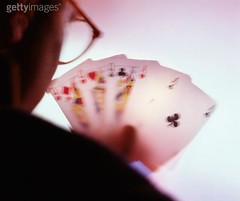Fighting Off the Monkey
 "Is this the gamblers training?" the two women asked, peering into our meeting room at a local convention center. I sent them across the hall, curious about the "type" who would attend. Their most outstanding feature? They looked absolutely normal. If I didn't know better, they could have been any group of bureaucrats, middle managers, or insurance adjusters taking a two-day training on the new state "rules and regs." No hot young hipsters in trendy leather or denim, but plenty of Dockers, parkas, and polar fleece. There were more women than I expected. And lots of smokers.
"Is this the gamblers training?" the two women asked, peering into our meeting room at a local convention center. I sent them across the hall, curious about the "type" who would attend. Their most outstanding feature? They looked absolutely normal. If I didn't know better, they could have been any group of bureaucrats, middle managers, or insurance adjusters taking a two-day training on the new state "rules and regs." No hot young hipsters in trendy leather or denim, but plenty of Dockers, parkas, and polar fleece. There were more women than I expected. And lots of smokers.Gambling in our state has grown into a 1.5 BILLION dollar industry (that's just for the tribal casinos) and until this year, the amount spent on gambling addicts was ZERO. Well, there was one year when the Mega Millions Lottery paid for some treatment but those funds ran out quickly. In the past decade, the number of Gamblers Anonymous chapters in the Seattle area alone grew from 4 to 28. Oregon, our neighbor to the south, spends $3 million dollars per year on its gambling problem, the kind of investment that could also pay off for us. The social effects of gambling addiction -- in the form of crime, divorce, bankruptcy, unemployment, and additional imprisonment -- cost state taxpayers $78 million each year.
Finally this spring the state legislature -- at the same time they are increasing gambling oppportunities -- approved a tax on the state lottery and local card rooms to raise a half million dollars per year. That's enough to offer help to thousands of addicts each year. Some Indian tribes kicked in another half million.
Lest we think these are out-of-control strangers who aren't like the rest of us, here's a profile of the five percent of the population who can't resist temptation:
- White
- Middle-aged (average age of 43)
- Equally likely to be male or female
- Equally likely to be single, married or divorced
- High school graduate with some college education
- Has a moderately skilled occupation
- Works full-time
- Makes less than $30,000 per year
- Began to gamble before age 21
- Preferred game is either cards, such as blackjack and poker, or gambling machines, such as slots or VLTs (Video Lottery Terminals)
- Has lost between $1,000 and $5,000 in a single day of gambling
- Gambles almost every day
- Has accrued a gambling-debt of $30,000
- Has borrowed money from family, credit cards, and against a checking account
- Has written bad checks but has not been arrested
- Has sold stocks and cashed in life insurance policies to cover gambling debts
- Has skipped work to gamble
- Is a daily smoker
- Drinks occasionally
Replace all the gambling references with some other vice (overeating, shoppping too much, or smoking too much marijuana) and this sounds like half of my friends. Years ago, gambling addicts could avoid indulging their compulsion because there was no action in their neighborhood, but when the card rooms and casinos came to town, they were drawn to the thrill of chance like a tippler to a tavern or a bulimic to a buffet.
From what I have read, the class next door might actually offer long-lasting results. I hope so. It's no fun wrestling with a compulsion. And we all wrestle with something. On my drive home, I passed at least three card rooms that I had never noticed before. Temptation staring them in the face every day. Just like the Krispy Kreme store slowly sliding by my window as I headed for home.




0 Comments:
Post a Comment
<< Home